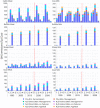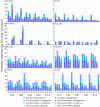Carbon myopia: The urgent need for integrated social, economic and environmental action in the livestock sector
- PMID: 34314548
- PMCID: PMC9290661
- DOI: 10.1111/gcb.15816
Carbon myopia: The urgent need for integrated social, economic and environmental action in the livestock sector
Abstract
Livestock have long been integral to food production systems, often not by choice but by need. While our knowledge of livestock greenhouse gas (GHG) emissions mitigation has evolved, the prevailing focus has been-somewhat myopically-on technology applications associated with mitigation. Here, we (1) examine the global distribution of livestock GHG emissions, (2) explore social, economic and environmental co-benefits and trade-offs associated with mitigation interventions and (3) critique approaches for quantifying GHG emissions. This review uncovered many insights. First, while GHG emissions from ruminant livestock are greatest in low- and middle-income countries (LMIC; globally, 66% of emissions are produced by Latin America and the Caribbean, East and southeast Asia and south Asia), the majority of mitigation strategies are designed for developed countries. This serious concern is heightened by the fact that 80% of growth in global meat production over the next decade will occur in LMIC. Second, few studies concurrently assess social, economic and environmental aspects of mitigation. Of the 54 interventions reviewed, only 16 had triple-bottom line benefit with medium-high mitigation potential. Third, while efforts designed to stimulate the adoption of strategies allowing both emissions reduction (ER) and carbon sequestration (CS) would achieve the greatest net emissions mitigation, CS measures have greater potential mitigation and co-benefits. The scientific community must shift attention away from the prevailing myopic lens on carbon, towards more holistic, systems-based, multi-metric approaches that carefully consider the raison d'être for livestock systems. Consequential life cycle assessments and systems-aligned 'socio-economic planetary boundaries' offer useful starting points that may uncover leverage points and cross-scale emergent properties. The derivation of harmonized, globally reconciled sustainability metrics requires iterative dialogue between stakeholders at all levels. Greater emphasis on the simultaneous characterization of multiple sustainability dimensions would help avoid situations where progress made in one area causes maladaptive outcomes in other areas.
Keywords: adaptation; carbon dioxide removal (CDR); carbon neutral; climate change; emissions intensity; maladaptation; multidisciplinary; policy; socio-economic; sustainable development goals.
© 2021 The Authors. Global Change Biology published by John Wiley & Sons Ltd.
Figures









References
-
- Abbott, D. W. , Aasen, I. M. , Beauchemin, K. A. , Grondahl, F. , Gruninger, R. , Hayes, M. , Huws, S. , Kenny, D. A. , Krizsan, S. J. , Kirwan, S. F. , Lind, V. , Meyer, U. , Ramin, M. , Theodoridou, K. , von Soosten, D. , Walsh, P. J. , Waters, S. , & Xing, X. (2020). Seaweed and seaweed bioactives for mitigation of enteric methane: Challenges and opportunities. Animals, 10. - PMC - PubMed
-
- Abernethy, B. , & Rutherford, I. (1999). Guidelines for stabilising stream banks with riparian vegetation (pp. 1–137). Cooperative Research Centre for Catchment Hydrology. Department of Geography and Environmental Studies, University of Melbourne.
-
- Ahmed, M. , Ahmad, S. , Waldrip, H. M. , Ramin, M. , & Raza, M. A. (2020). Whole farm modeling: A systems approach to understanding and managing livestock for greenhouse gas mitigation, economic viability and environmental quality. In H. Waldrip, P. Pagliari & Z. He (Eds.), Animal manure. 10.2134/asaspecpub67.c25 - DOI
-
- Alcock, D. J. , Harrison, M. T. , Rawnsley, R. P. , & Eckard, R. J. (2015). Can animal genetics and flock management be used to reduce greenhouse gas emissions but also maintain productivity of wool‐producing enterprises? Agricultural Systems, 132, 25–34. 10.1016/j.agsy.2014.06.007 - DOI
Publication types
MeSH terms
Substances
Grants and funding
LinkOut - more resources
Full Text Sources

